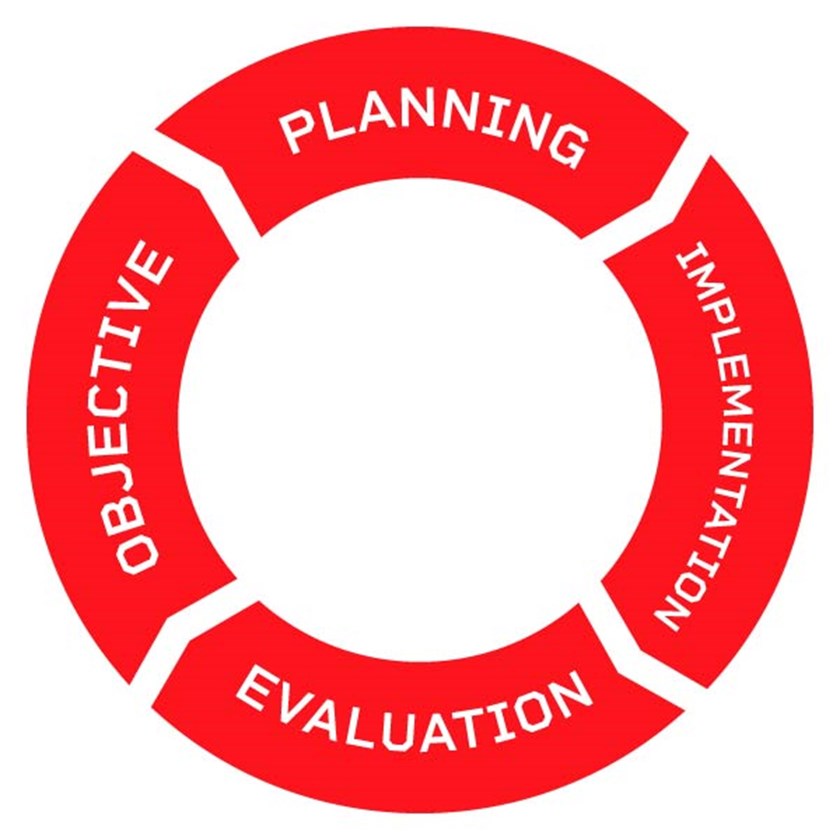Training Sessions

Planning
In order to be successful in coaching, the coach must be well prepared and plan ahead.
The importance of planning cannot be underestimated.
A team’s training schedule should be organised and planned to ensure goals are achieved.
The planning process therefore should be an organised and methodical procedure that assists the players and coach to achieve predetermined standards.
To determine the success of the yearly plan, it is essential that a thorough evaluation is completed by the coach, assistant coaches and players.
An evaluation at the end of each phase of the yearly plan enables the coach to modify the plan for the upcoming phase.
At the end of the year, an evaluation will enable the coach to make modifications to the plan for the next year.
Click here for an example training template.pdf
The Training Session
The training session is the basic building block of coaching.
At training, skills are learned, conditioning and fitness levels are achieved, and team confidence is developed.
In rugby league, the training session, will contain various drills set between a warm-up at the beginning and a cool down at the end.
To decide on what drills are suitable for a particular session, the coach must first evaluate the team performance and then plan for optimal practice time.
Goals should be established before each segment of a training session.
This will ensure individual and team deficiencies and strengths will be focused on.
Players should be educated to analyse their own performance and set personal goals for training so that they attend training with a purpose in mind.
When planning a training session, the following considerations should be noted:
- Venue
- Various venues can be used during the year, particularly in the pre-season period. In addition to their home ground, coaches should seek alternative venues ranging from athletic tracks or swimming pools to a well-grassed hilly surface, indoor gymnasium or basketball court. If carefully selected, these venues can greatly improve the general standard of training.
- Equipment
- The well-prepared coach will have a variety of equipment on hand at training. This can include: Footballs, ball pump, cones, whistle, stopwatch, hit pads, adequate supply of water for players during and after training.
- Outline of the training session
- Many coaches provide the players with an outline of the training session before training. Players can be informed on the overall aims of the session in addition to the approximate length and intensity of the practice.
- Be specific
- Training must be specific to the demands of the game. The game demands that decision-making skills, implementation of core/ essentials skills, the style of play and team-plan to be part of the training program. The effective coach will incorporate these components with the idea of practise as you play and play as you practise, highlighting the importance of specificity within the training session.
- Quality not quantity
- In general terms, the emphasis should be put on a quality non-stop training session rather than one of low volume and long duration.
The Training Session – In Season
The primary objective during the playing season is to maintain the level each/every player’s level of match fitness. In addition, it is important to develop individual and team skills through a good selection of drills.
Format of a training session:
- Warm-up
- Your warm-up should include dynamic stretching and flexibility exercises. Skill exercises should also be included – for example grip, catch, pass, draw and pass etc. There are no time limits to the average length of the warm-up. An adequate warm-up must ensure the players’ muscles are prepared for action and the players themselves are ‘tuned in’ ready to perform to their optimum. Generally, 10 minutes is adequate.
- Skills section
- Skill practice should occupy 40-50 minutes of the session. It has two general components:
- Revision of previously acquired skills or strategies and introduction of a new skill or strategy.
- Drills will be performed involving groups of players working together. Specific skills e.g. grip, catch & pass, draw & pass, tackle technique (e.g. 1 on 1, 2 on 1 etc). Training drills that emphasise team plays are also practised. These can include kick-off practice, scrums, taps or dropouts. Drills must be realistic and complement the game situation. Functional training is the key to success on match-day. A ‘game-centred’ component in the training session allows the players to practise decision-making and aids in the development of strategically thinking players.
- Warm-down
- After a training session, players should be given a cool-down period of at least 5 minutes to allow the body to gradually return to its resting state.
- Post-training evaluation
- The training session should be evaluated immediately after it has concluded. The coach and their assistants should readily assess the effectiveness of the session and the performance of individual players. This will be valuable in planning future training activities.

The training session is the basic building block of coaching. In order to conduct a meaningful and successful training session the coach should follow the four stages of planning outlined below:
- Set the overall goals/objective
- Decide how this session fits into the overall picture of training. Each training session should be organised and seen as part of a series.
- Set specific goals and objectives
- Decide which individual and team skills or energy systems will be developed in the session. Training must reflect the game situation and be designed to improve team strengths.
- Building the principles of effective training sessions
- Successful training will result if the coach is aware of the following principles of effective training.
- Design the training session
- Be prepared. Make sure you know every element of what is to come before you begin.
Principles of effective training
The coach needs to be aware of the general principles to ensure effective training.
Awareness makes it possible for coaches to formulate training programs and sessions that have a positive impact on both the team and the individual.
In becoming aware of the principles of effective training, coaches are able to design their training with appropriate consideration to the standard of the team.
- Plan, yet be flexible
- Time spent in organising the training session will make it easier for the players and the sequence of activities will flow. If a planned activity is not working or circumstances have changed (e.g., weather or reduced numbers), be prepared to adjust the activity to make it work.
- Give clear, concise instructions
- Be clear in your instructions. To stop an activity, use one clear word “stop” or a whistle. Before speaking, make sure all the group is in, and in front of you, so that you can see all the players. Keep instructions to a minimum by emphasising the main coaching points. Learning and motivation improves when the player knows what is expected.
- Demonstrations improve the accuracy of instructions
- When providing a demonstration, be conscious of the best viewing angles for the players to observe the demonstration. Repeat the demonstration a couple of times before instructing them to preform that skill, drill or exercise.
- Give positive feedback
- Observe your players during each of the activities, moving to individuals or groups that may need assistance. Emphasise and reward good performance and encourage the effort that is made to achieve the task.
- Provide variety
- Maintain interest by using various warm-ups, drills, skill practices and modified games and guest coaches.
- Encourage enjoyment
- Training sessions should be fun, enjoyable and demanding. Players should look forward to coming to training through the content of the session as well as your passion and enthusiasm for the session.
- Create progression
- Learning improves if you plan for progressive skill development. Moving from simple to more complex skills facilitate this improvement.
- Allow for individual differences
- Allow for different learning rates by being patient with the players who are progressing at a different rate than other players. Players will be at different stages of learning. Grouping players according to different skill levels or using more skilled players to assist less-skilled players facilitates the learning process.
- Keep all players active
- Maximise training time by keeping all players active and involved, being conscious of appropriate work-to-rest ratios. A skilful coach can judge when to stop an activity and move on to the next activity. Stop the activity when you are curtain of what you are going to say and the next activity is set up.
- Communicate
- Make every effort to speak with and listen to as many players as possible on a regular basis. Communicate with players about their game as well their school life, their social life or work.
How to introduce a new skill or drill
Skills are the lifeblood of training sessions and ultimately reflect the team’s on-field performance. Coaches often waste valuable time and become frustrated at their lack of success when introducing a skill or drill for the first time. A simple procedure to follow is set out below:
- Have all the equipment ready
- It may seem self-explanatory, but it is an important part of running a successful coaching session. Coaches must be able to move players quickly from one drill to the other. A new skill or drill can quickly lose its appeal, regardless of its value, if the appropriate preparation doesn’t appear to have been made.
- Rehearse selected players to go through the drill before the whole team is involved
- If certain players within the group have an understanding of the skill or drill, then they will quickly be able to explain to other players what needs to be done. Communication among players builds a sense of team.
- Explain the aim of the drill
- By explaining the aim of the drill, players will be able to see for themselves the inherent value of performing every part of the drill with enthusiasm. It will also serve as a guide to the type of skills the coach believes the team needs to work on.
- Selected players to walk through the skill or drill
- As in point 2, players can observe the drill being performed, avoiding confusion.
- Give the skill or drill a name
- This saves the coach having to remind players of the drill each time it is to be used. If players are aware of the name of the drill, the team can immediately move on to it. A continuous training session is of enormous value. Naming it after a player who does the drill well is one way.
- When the whole group is ready, begin by performing the drill slowly
- A new drill should be eased into so that players can gain confidence in the way it operates and concentrate more on the skills they are trying to develop than the actual machinations of the training drill.
- Gradually increase the tempo and degree of difficulty
- There are several ways to lift the pace:
- adding more footballs or
- having less defenders and more attacking players.
- It is important to add variety to drills so that players believe they are continuing to gain value out of it. By adding more footballs, you add to the pace at which the drill is performed. Players must always concentrate, which also replicates a match situation more closely. As the players become more confident and drills are known, the players often do not need explanations before performing a drill.
- There are several ways to lift the pace:
A great coach not only inspires but supports and encourages others to get results
Game sense and decision-making training
Training players to think
Game sense is an approach to coaching that uses games as the focus of the training session. By focusing on the game (not necessarily the full game), players are encouraged to:
- Become more tactically aware and be able to make better decisions during the game in pressure situations.
- Start thinking strategically about game concepts.
- Continue to further develop skills such as grip, catch and pass, tackle technique under pressure within a realistic and enjoyable context.
- Develop a greater understanding of the game being played.
- Increase individual and team motivation to training – players love to play games!
- Physiologically prepare the body where conditioning is specific to the game.
Why use game sense?
The fact that games are intrinsically motivating is probably the best reason why coaches should adopt game sense, but there are several other reasons for using this approach:
- Encourages a holistic approach to the teaching of games – players are taught to solve problems that arise in a game through tactical awareness and understanding; skills are developed in a more meaningful environment.
- Promotes enjoyment for participation – a fun environment increases motivation levels and encourages participation.
- Assists the beginner, who often has limited technical knowledge of a sport. For coaches of beginning players, it is more appropriate to set challenges for players through games rather than conduct technique-based sessions.
- Coach talks and intervention is kept to a minimum – the coach questions players to challenge them to find solutions. Rather than providing all the answers; cooperation between the coach and the players is increased due to the player involvement. Providing tactical situations that are repetitive within small-sided games assists players to improve their decision-making ability through experience and learning from their good and poor decisions.
Modifying a game for a purpose
With a game sense approach to coaching and teaching skills, the coach as facilitator plays a very important role in modifying games to emphasise or exaggerate a particular aspect or theme, for example:
- Number of players – 2-6 to maximise decisions (8v6, 6v4, 5v3 etc).
- Size of playing area.
- The main game rules etc.
- Scoring areas.
- Structure of scoring system
Many effective training sessions are mixtures (a balance) of the two. When developing games for a particular purpose, as a coach you must have answers to some key questions before explaining the drill to your team.
Some questions to think about when developing your game sense drills can include:
- What themes or tactics do I want to focus on in the game?
- What will be the main challenges to the players?
- What are the rules and who will referee?
- What will the dimensions of the playing area be?
- How can I extend or modify the game to continually challenge the players?
- How can I construct bias if necessary to make individuals work harder than others?
When discussing game sense, one very important aspect is that of questioning players on specific outcomes or focusing on specific aspects, which have been evident or not evident during the game.
It is important not to spend too long questioning the team as part of the success of a game sense approach is in fact the playing. Questions will generally relate to aspects of the game and are used to enable players to reflect and then visualise in a match-day situation.

The Dolphins respect and honour the Traditional Custodians of the land and pay our respects to their Elders past, present and future. We acknowledge the stories, traditions and living cultures of Aboriginal and Torres Strait Islander peoples on the lands we meet, gather and play on.

